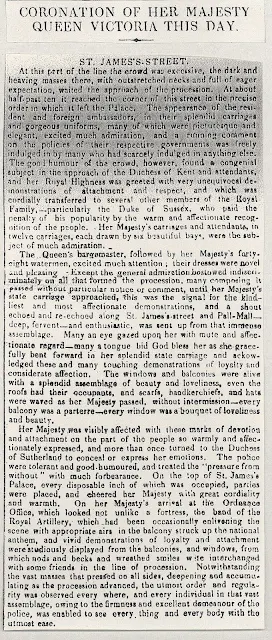Extract from The Globe newspaper, 28 June 1838
Coronation
of Her Majesty Queen Victoria This Day
St
James’s- Street
At
this part of the line the crowd was excessive, the dark and heaving masses
there, with
outstretched necks and full of eager expectation, waited the approach of the procession.
At about half-past ten it reached the corner of this street in the precise order
in which it left the Palace. The appearance of the resident and foreign ambassadors,
in their splendid carriages and gorgeous uniforms, many of which were picturesque
and elegant, excited much admiration, and a running comment on the policies
of their respective governments was freely indulged in by many who had scarcely
indulged in anything else. The good humour of the crowd, however, found a congenial
subject in the approach of the Duchess of Kent and attendants, and her Royal
Highness was greeted with very unequivocal demonstrations of attachment and respect,
and which was cordially transferred to several other members of the Royal Family,
- particularly the Duke of Sussex, who paid the penalty of his popularity by the
warm and affectionate recognition of his people. Her majesty’s carriages and attendants,
in twelve carriages, each drawn by six beautiful bays, were the subject of much
admiration.
The
Queen’s bargemaster, followed by her Majesty’s forty-eight watermen, excited much
attention; their dresses were novel and pleasing. Except the general admiration bestowed
indiscriminately on all that formed the procession, many composing it passed
without particular notice or comment, until her Majesty’s state carriage approached,
this was the signal for the kindliest and most affectionate demonstrations, and
a shout echoed and re-echoed along St. James’s-street and pall-Mall – deep, fervent
– and enthusiastic, was sent up from immense assemblage. Many an eye gazed upon
her with mute and affectionate regard – many a tongue bid God bless as she gracefully
bent forward in her splendid state carriage and acknowledged these and many
touching demonstrations of loyalty and considerate affection. The windows and balconies
were alive with a splendid assemblage of beauty and loveliness, even the roofs
had their occupants, and scarfs, handkerchiefs, and hats were waved as her
Majesty
passed, without intermission, – every balcony was a parterre – every window was
a bouquet of loveliness and beauty.
Her
Majesty was visibly affected with these marks of devotion and attachment on the part
of the people so warmly and affectionately expressed, and more than once turned to
the Duchess of Sutherland to conceal or express her emotions. The police were tolerant
and good-humoured, and treated the “pressure from without” with much
forbearance.
On the top of St. James’s Palace, every disposable inch of which was occupied,
parties were placed and cheered her Majesty with great cordiality and warmth.
On her Majesty’s arrival at the Ordnance Office, which looked not unlike a fortress,
the band of the Royal Artillery, which had been occasionally enlivening the scene
with appropriate airs in the balcony struck up the national anthem, and vivid demonstrations
of loyalty and attachment were studiously displayed from the balconies,
and windows, from which nods and becks and wreathed smiles were interchanged
with some friends in the line of procession. Notwithstanding the vast masses
that pressed on all sides, deepening and accumulating as the procession advanced,
the utmost order and regularity was observed every where and every individual
in that vast assemblage, owing to the firmness and excellent demeanour of the
police, was enabled to see everything and everybody with the utmost ease. © Royal Archives, Windsor Castle
Queen Victoria Receiving the Sacrament at her Coronation 28 June 1838 painted by Charles Robert Leslie (1794-1859) in 1838-9.
Painted for Queen Victoria . The painting shows the Queen, wearing the Dalmatic Robe but not the
Crown and no jewels, receiving the Sacrament towards the end of the
ceremony of her Coronation. The peers and peeresses have taken off their
coronets. The Sacrament is being administered by the Archbishop of
Canterbury, William Howley, assisted by the Sub-Dean, the Reverend Lord.
Alfred Lord Tennyson’s first poem (in his own handwriting) as Poet Laureate, ‘To the Queen,’ was published as the dedication poem of the Laurete Edition (the 7th edition) of the Poems in 1851.
Alfred Lord Tennyson’s first poem (in his own handwriting) as Poet Laureate, ‘To the Queen,’ was published as the dedication poem of the Laurete Edition (the 7th edition) of the Poems in 1851.
To the Queen
By Alfred, Lord Tennyson (1809–1892)







2 comments:
Hello Kimberly,
I love the way in which this article is written, such eloquence of the time, its almost Shakespearian in language.
Queen Victoria was one of our greats who is still very much respected. She touched so many hearts and continues to do so.
Thank you for sharing.
Kind regards
Kevin Marsh
Hi Kevin,
I couldn't agree more! I love reading 19th century newspapers for just those same reasons. I also loved the paintings as well. Thanks so much for stopping by and commenting. Cheers to Queen Victoria :)
Post a Comment